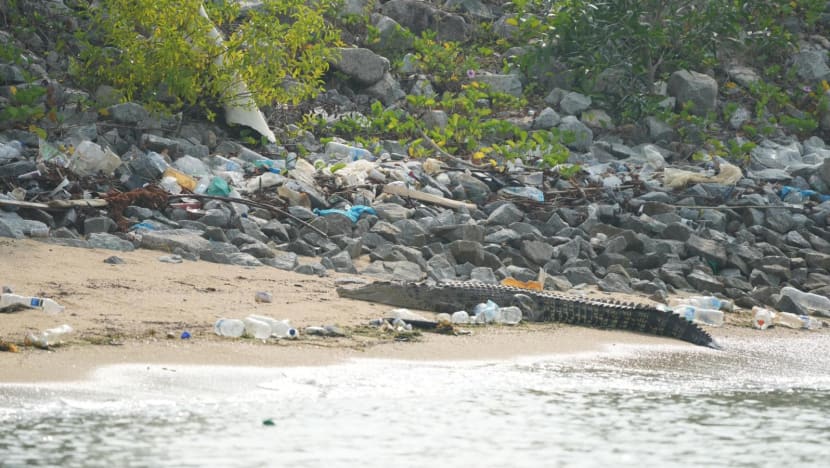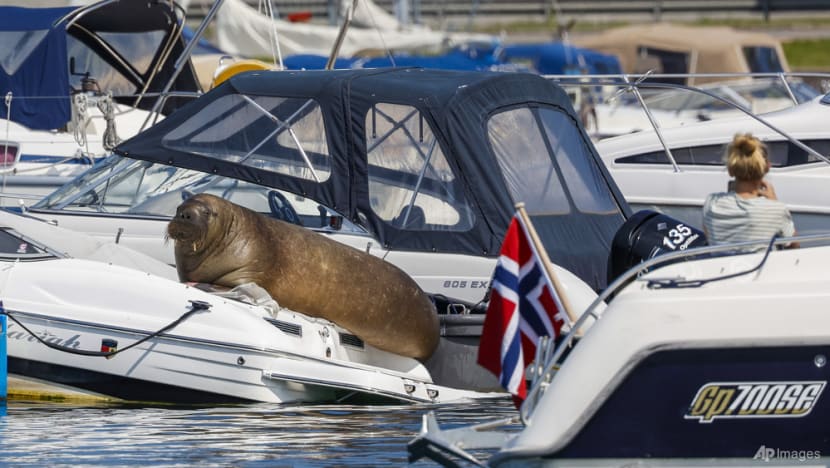Commentary: The real tragedy of Marina East crocodile is there was no real alternative to putting it down
The Marina East crocodile will not be the last wild animal to show up in an unexpected place in Singapore. We need to prove that we can be a country where human safety and biological conservation are not mutually exclusive, says Herpetological Society of Singapore’s Sankar Ananthanarayanan.

A crocodile was spotted on Marina East beach on Oct 10, 2023. (Photo: Facebook/CK Lee)
SINGAPORE: I am perpetually in awe at the fact that the largest reptile species in the world - the saltwater crocodile or Crocodylus porosus - can be found right here in urban Singapore.
Then news emerged that a nearly 3m-long crocodile had come up onto Marina East Drive Beach, before being captured and ultimately euthanised on Oct 12. Excitement quickly gave way to exasperation.
Saltwater crocodiles are considered nationally critically endangered and are threatened by the destruction of estuarine mangroves and, pertinently, human persecution.
This was in stark contrast with the case of the Malayan tapir sighted in Punggol in July and in September. Advisories warning people to maintain safe distances were issued, and signs were posted around the park, proclaiming the same.
Like the tapir, this crocodile was also a possibly transient individual on the move who just stopped on our shores to bask in the sun, as crocodiles do. Why were these two cases treated differently?
As an educator, one of the things I teach my students is to guard their “emotional buttons”. And as a reptile lover myself, I could feel my own buttons being pressed as this story developed.
I saw it too in the reactions on social media: Some argued that crocodiles could pose a danger to beachgoers, especially families with young children. Others were unhappy that Singapore resorted to killing animals without fully exploring alternatives.
ONLY A MATTER OF TIME BEFORE A NEGATIVE INCIDENT
Of course, saltwater crocodiles are large carnivores. But tapirs are 300kg relatives of the rhino and can be dangerous in their own right. As with almost all wildlife, they pose no direct threat to us if people maintain a safe distance.
However, given Singapore’s population density and the shocking intensity with which we use the land around us, it is only a matter of time before negative interactions occur.
On numerous occasions, I have encountered hikers and photographers bashing off trails in the nature reserves. In April, two hikers went missing in the forests of the Central Catchment Nature Reserve, requiring rescue.
Should such incidents occur involving careless humans and a crocodile in the wild, they would have severe implications for the future of the crocodile population in Singapore. Unfortunately, as a nation, we have not yet developed the social etiquette and respect for nature required to coexist with these spectacular creatures.
Even in Norway, a walrus named Freya, which became famous for climbing onto boats to bask and sinking them, was shot by the authorities in August 2022 in the interest of public safety. Despite warnings that the 600kg tusked walrus could be dangerous, members of the public approached the animal, some even taking selfies or swimming up close.
Critics of the decision called for more patience in wildlife management, and to allow biodiversity a fair chance to find space in an increasingly human-dominated world.

IS EUTHANASIA THE ONLY WAY?
It is tempting to seek somebody to point the finger at, or somebody to blame. But it would be disingenuous of us to play armchair conservationists, criticising choices made on the ground and suggesting that alternative methods had not been considered or this decision was taken lightly.
The National Parks Board (NParks), which had to make this decision, has the thankless task of balancing biodiversity conservation and the general public’s safety.
Oftentimes, as it is in this case, there is not an entity to blame, but a set of circumstances that culminate in difficult decisions. “Who is to blame for this?” is a much less important question than “Where shall we go from here?”
Several alternative options have been bandied around social media, including relocating the crocodile to Sungei Buloh Wetland Reserve, where crocodiles have been translocated to in the past. But Sungei Buloh has reached a high population density of crocodiles - of about 20 reptiles, according to NParks.
It is not sustainable to keep translocating crocodiles into an already saturated space that may not have sufficient resources to support them. This is both a function of the fact that crocodiles are apex predators, and that healthy mangroves and estuaries are a rarity in modernised Singapore.
The Mandai Wildlife Group has also since clarified that it was not able to take in this crocodile in a way that would be appropriate for the animal and the zoo.
DON’T OVERLOOK SCIENCE COMMUNICATION
Given the additional clarifications about alternatives for the Marina East Drive crocodile, some may be able to approach this situation rationally. I believe these clarifications and information could have been better communicated along with the initial decision to put down the animal.
Singapore has adopted a robust evidence-based approach towards planning and conservation as it builds a City in Nature. But it is important to remember that science communication is an integral (and often overlooked aspect) of science.
Public transparency in data and in the decision-making process, is a critical stepping stone towards having a well-informed population that trusts its operating bodies. A step in this direction can improve the quality of public discourse by minimising well-meaning but uninformed opinions from proliferating.
Development and nature conservation are often at odds with each other. As we lose more and more of these habitats in Singapore, such difficult choices will become more commonplace. Education is our most powerful weapon against conflict.
It is a tragedy that the crocodile had to be put down. Perhaps what makes this even more tragic is the fact that there was not really another way to manage this situation, given the potential risk to public safety and the ecological ground truth.
But this will certainly not be the last wild animal (or even the last crocodile) to show up in an unexpected place in Singapore. We need to be able to learn from this incident and prove that we can indeed be a City in Nature where human safety and biological conservation are not mutually exclusive.
Sankar Ananthanarayanan is co-founder of the Herpetological Society Singapore.










